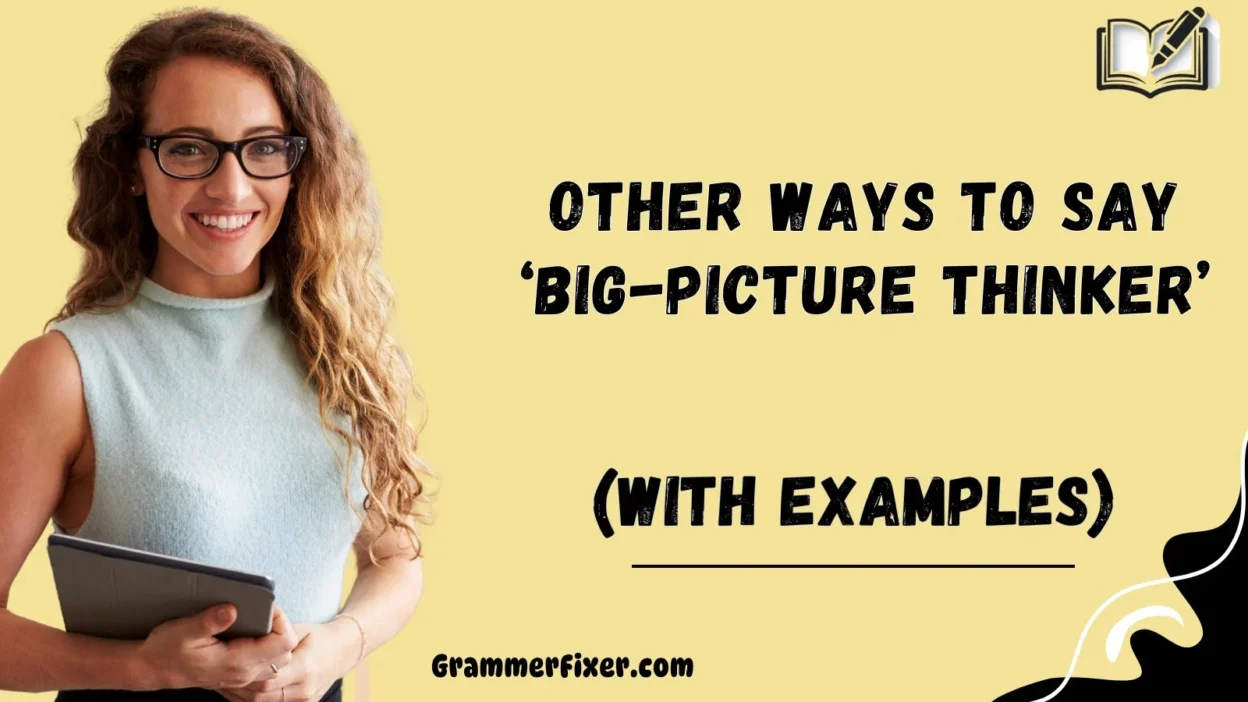Finding the right words for your resume or professional profile is more than just polishing—it’s about conveying your essence with warmth, clarity, and purpose. When you want to highlight yourself as a big-picture thinker, choosing the right synonym can make your application feel more personal, thoughtful, and impactful.
Below are 30 meaningful alternatives, complete with explanations and examples, to help you showcase your vision, foresight, and leadership in a way that feels authentic and professional.
What Does “Big-Picture Thinker” Mean?
A big-picture thinker is someone who looks beyond the small details and instead sees the overall direction, outcomes, and long-term impact. It describes a person who can analyze complex scenarios, anticipate changes, and create strategies that align with larger goals.
When to Use “Big-Picture Thinker”?
Use it when you want to emphasize your ability to strategize, plan long-term, and connect dots across multiple areas. It’s best placed in resume summaries, cover letters, or leadership roles where vision and strategy matter.
Is It Professional/Polite to Say “Big-Picture Thinker”?
Yes, it is professional and widely accepted in corporate language. However, it can sometimes sound a bit generic or overused, which is why synonyms and alternatives can help you stand out.
Pros or Cons
Pros:
- Shows strategic foresight
- Highlights leadership qualities
- Suggests long-term planning skills
Cons:
- Can feel vague or overused if not supported with examples
- May come across as buzzword-heavy without real substance
1. Visionary
Meaning: Someone with a clear foresight who imagines and pursues future opportunities.
Explanation: A visionary goes beyond daily tasks and shapes ideas that inspire growth.
Scenario Example: “Visionary leader who guided a cross-functional team toward sustainable solutions.”
Best Use: Leadership roles, strategic planning.
Worst Use: Entry-level resumes without evidence of leadership or future-oriented achievements.
Tone: Inspirational, forward-looking.
2. Strategic Thinker
Meaning: Focuses on long-term planning and aligning decisions with broader objectives.
Explanation: Strategic thinkers analyze, anticipate, and orchestrate actions for company-wide success.
Scenario Example: “Recognized as a strategic thinker who aligns initiatives with organizational goals.”
Best Use: Management, consulting, executive roles.
Worst Use: Generic applications where the job requires hands-on execution more than planning.
Tone: Professional, precise.
3. Forward-Thinking Professional
Meaning: A person who is proactive, innovative, and anticipates trends.
Explanation: Being forward-thinking means not just reacting but staying ahead of challenges.
Scenario Example: “Forward-thinking professional who developed future-focused marketing strategies.”
Best Use: Resume profiles, innovation-driven roles.
Worst Use: Overly formal industries (like law or auditing) where risk-taking isn’t valued.
Tone: Modern, adaptive.
4. Innovative Leader
Meaning: Someone who introduces creative solutions while maintaining the big picture.
Explanation: Blends innovation with leadership, spearheading new initiatives.
Scenario Example: “Innovative leader who spearheaded digital transformation campaigns.”
Best Use: Technology, creative industries, startups.
Worst Use: Roles that demand strict process adherence and little room for creativity.
Tone: Dynamic, creative.
5. Holistic Thinker
Meaning: Looks at problems and solutions in a comprehensive, interconnected way.
Explanation: A holistic thinker considers diversity, systems, and broader outcomes.
Scenario Example: “Holistic thinker with a global perspective on organizational growth.”
Best Use: Cross-cultural, global companies.
Worst Use: Short-term project roles where detailed execution matters more than vision.
Tone: Inclusive, thoughtful.
6. Strategic Planner
Meaning: Skilled in developing actionable long-term plans.
Explanation: Focused on clarity, methodology, and execution.
Scenario Example: “Strategic planner with expertise in company-wide initiatives.”
Best Use: Corporate planning, operations.
Worst Use: Situations where flexibility and improvisation are more valued than rigid plans.
Tone: Clear, structured.
7. Macro-Level Analyst
Meaning: Focuses on the large-scale impacts of data and trends.
Explanation: Analyzes economic, political, or industry-wide changes.
Scenario Example: “Macro-level analyst experienced in anticipating market shifts.”
Best Use: Finance, economics, international business.
Worst Use: Detail-heavy roles (like bookkeeping or administrative tasks) that demand micro-level focus.
Tone: Analytical, professional.
8. Global Mindset Professional
Meaning: Brings a worldly outlook and considers international perspectives.
Explanation: Navigates cultures, markets, and industries with ease.
Scenario Example: “Global mindset professional with cross-cultural leadership skills.”
Best Use: Multinational corporations, international relations.
Worst Use: Small, local companies that operate solely in domestic markets.
Tone: Inclusive, expansive.
9. Long-Term Strategist
Meaning: Plans with the future in mind, beyond short-term results.
Explanation: Ensures sustainable growth and development.
Scenario Example: “Long-term strategist focused on five-year expansion goals.”
Best Use: Growth-focused companies, executive teams.
Worst Use: Freelance or contract work where only immediate delivery is expected.
Tone: Steady, growth-driven.
10. Systems Thinker
Meaning: Understands how different components interconnect.
Explanation: Recognizes that every decision impacts the broader system.
Scenario Example: “Systems thinker who integrates technology and operations smoothly.”
Best Use: Operations, IT, organizational design.
Worst Use: Narrow, specialized roles where broader connections don’t apply.
Tone: Logical, integrated.
11. Vision-Driven Leader
Meaning: A leader who motivates teams with a clear sense of direction and mission.
Explanation: This person ties everyday actions to the larger company mission, ensuring alignment.
Scenario Example: “Vision-driven leader who inspires teams to align with long-term organizational goals.”
Best Use: Executive roles, non-profits, corporate mission-oriented environments.
Worst Use: Entry-level resumes where leadership opportunities haven’t been demonstrated yet.
Tone: Motivational, value-centered.
12. Futuristic Thinker
Meaning: Anticipates future scenarios, technologies, and industry changes.
Explanation: Futuristic thinkers help organizations stay ahead of the curve.
Scenario Example: “Futuristic thinker who designed innovation strategies to prepare for digital transformation.”
Best Use: Technology, R&D, forward-focused industries.
Worst Use: Traditional industries (like government clerical work) where innovation isn’t the priority.
Tone: Bold, progressive.
13. Comprehensive Planner
Meaning: Someone who creates thorough, well-rounded plans that consider multiple angles.
Explanation: Goes beyond surface-level planning, ensuring clarity, sequence, and execution.
Scenario Example: “Comprehensive planner who led departmental initiatives across finance and operations.”
Best Use: Large-scale project management, corporate planning.
Worst Use: Fast-paced startups that prioritize agility over exhaustive plans.
Tone: Detailed, reliable.
14. Elevated Thinker
Meaning: Brings a high-level perspective that lifts conversations and decisions beyond the ordinary.
Explanation: Focuses on elevated outcomes, avoiding distractions in the details.
Scenario Example: “Praised as an elevated thinker who contributes clarity in board-level decisions.”
Best Use: Senior roles, executive boards, leadership profiles.
Worst Use: Junior roles where execution and detail matter more than abstract thinking.
Tone: Refined, high-level.
15. Innovation-Driven Professional
Meaning: Prioritizes creativity and new ideas while keeping business objectives in focus.
Explanation: This professional ties innovation to practical business goals.
Scenario Example: “Innovation-driven professional who introduced three new revenue-generating initiatives.”
Best Use: Startups, R&D, marketing.
Worst Use: Highly regulated industries (like compliance or legal) where innovation is restricted.
Tone: Creative, energetic.
16. High-Level Strategist
Meaning: Operates at the macro level of planning, focusing on company-wide goals.
Explanation: Combines foresight, leadership, and decision-making.
Scenario Example: “High-level strategist experienced in aligning initiatives across departments.”
Best Use: Senior management, corporate executives.
Worst Use: Small roles where planning is limited to individual tasks only.
Tone: Professional, commanding.
17. Global Strategist
Meaning: Aligns strategies with international goals and markets.
Explanation: Considers diverse cultural, economic, and market contexts.
Scenario Example: “Global strategist skilled in navigating international business expansions.”
Best Use: Multinational corporations, global business leadership.
Worst Use: Local or small businesses without cross-border operations.
Tone: Expansive, international.
18. Conceptual Thinker
Meaning: Thrives on abstract ideas, frameworks, and theories that drive business solutions.
Explanation: Conceptual thinkers analyze, define, and design high-level concepts.
Scenario Example: “Conceptual thinker who developed new frameworks for digital transformation.”
Best Use: Consulting, strategy, academic-driven industries.
Worst Use: Execution-heavy jobs that require hands-on detail orientation.
Tone: Intellectual, abstract.
19. Foresightful Planner
Meaning: Plans with foresight, anticipating risks and opportunities.
Explanation: Balances clarity, risk management, and opportunity alignment.
Scenario Example: “Foresightful planner who anticipated market shifts, saving $2M in costs.”
Best Use: Risk management, finance, executive planning.
Worst Use: Roles where only immediate results matter, like sales quotas.
Tone: Calculated, prepared.
20. Visionary Strategist
Meaning: Combines visionary thinking with practical strategies.
Explanation: Moves beyond ideas into concrete, actionable strategies.
Scenario Example: “Visionary strategist who drove company-wide transformation initiatives.”
Best Use: Executive leadership, C-suite roles.
Worst Use: Jobs with narrow scope (e.g., entry-level assistant roles).
Tone: Bold, executive-level.
21. Proactive Leader
Meaning: Anticipates challenges and acts before problems arise.
Explanation: Brings initiative, foresight, and responsibility to leadership.
Scenario Example: “Proactive leader who identified and resolved potential workflow bottlenecks.”
Best Use: Team management, organizational leadership.
Worst Use: Overly hierarchical environments where initiative isn’t encouraged.
Tone: Responsible, confident.
22. Broad-Scope Thinker
Meaning: Focuses on wide-ranging issues instead of isolated problems.
Explanation: Evaluates decisions, outcomes, and impacts across multiple areas.
Scenario Example: “Broad-scope thinker with expertise in interdepartmental alignment.”
Best Use: Organizational development, large-scale projects.
Worst Use: Narrow technical jobs where deep specialization is required.
Tone: Wide-ranging, comprehensive.
23. Strategic Visionary
Meaning: Pairs strategic foresight with imaginative vision.
Explanation: Builds strategies based on clear goals and innovation.
Scenario Example: “Strategic visionary who led market expansion across two new regions.”
Best Use: Executive resumes, leadership profiles.
Worst Use: Short-term contract roles where strategy isn’t needed.
Tone: Inspiring, future-focused.
24. Organizational Strategist
Meaning: Designs strategies for company structure, growth, and alignment.
Explanation: Ensures departments and teams work together toward larger goals.
Scenario Example: “Organizational strategist with success in company-wide process overhauls.”
Best Use: HR leadership, corporate strategy, management consulting.
Worst Use: Small startups without structured departments.
Tone: Structural, organized.
25. Perspective-Oriented Professional
Meaning: Balances multiple perspectives when making decisions.
Explanation: Recognizes that different viewpoints shape better outcomes.
Scenario Example: “Perspective-oriented professional who integrates diverse cultural insights.”
Best Use: Diversity initiatives, multicultural workplaces.
Worst Use: Environments that prioritize strict process over inclusive thinking.
Tone: Empathetic, open-minded.
26. Change Navigator
Meaning: Helps organizations adapt to and thrive during change.
Explanation: Brings clarity and strategy to uncertain or transitional phases.
Scenario Example: “Change navigator who led teams through digital transformation.”
Best Use: Organizational development, transitional leadership roles.
Worst Use: Stable industries with minimal change.
Tone: Supportive, adaptive.
27. Outcome-Focused Leader
Meaning: Stays focused on results and long-term achievements.
Explanation: Guides teams by aligning efforts with measurable outcomes.
Scenario Example: “Outcome-focused leader who delivered 20% revenue growth.”
Best Use: Sales, marketing, business growth roles.
Worst Use: Research or experimental fields where results are uncertain.
Tone: Results-driven, motivating.
28. Big-Scale Planner
Meaning: Excels at planning large projects with multiple moving parts.
Explanation: Anticipates resources, risks, and outcomes across broad projects.
Scenario Example: “Big-scale planner who oversaw regional expansion campaigns.”
Best Use: Construction, operations, corporate expansion.
Worst Use: Small, individual roles with minimal planning.
Tone: Practical, large-scale.
29. Panoramic Thinker
Meaning: Views situations with a wide, panoramic perspective.
Explanation: Considers all angles before reaching conclusions.
Scenario Example: “Panoramic thinker with expertise in global marketing trends.”
Best Use: International markets, executive strategy.
Worst Use: Niche, highly specialized jobs with narrow focus.
Tone: Expansive, insightful.
30. Worldly Strategist
Meaning: Uses international experience and awareness to guide strategies.
Explanation: Understands cultures, politics, and economics at a global scale.
Scenario Example: “Worldly strategist who led multinational campaigns across five countries.”
Best Use: Multinational companies, global leadership.
Worst Use: Domestic-focused companies with no international scope.
Tone: Experienced, global-minded.
Conclusion
Choosing the right synonym for “big-picture thinker” can completely change how your resume, cover letter, or LinkedIn profile resonates with recruiters. Words carry weight, and the right ones not only showcase your skills but also your warmth, foresight, and authenticity.



